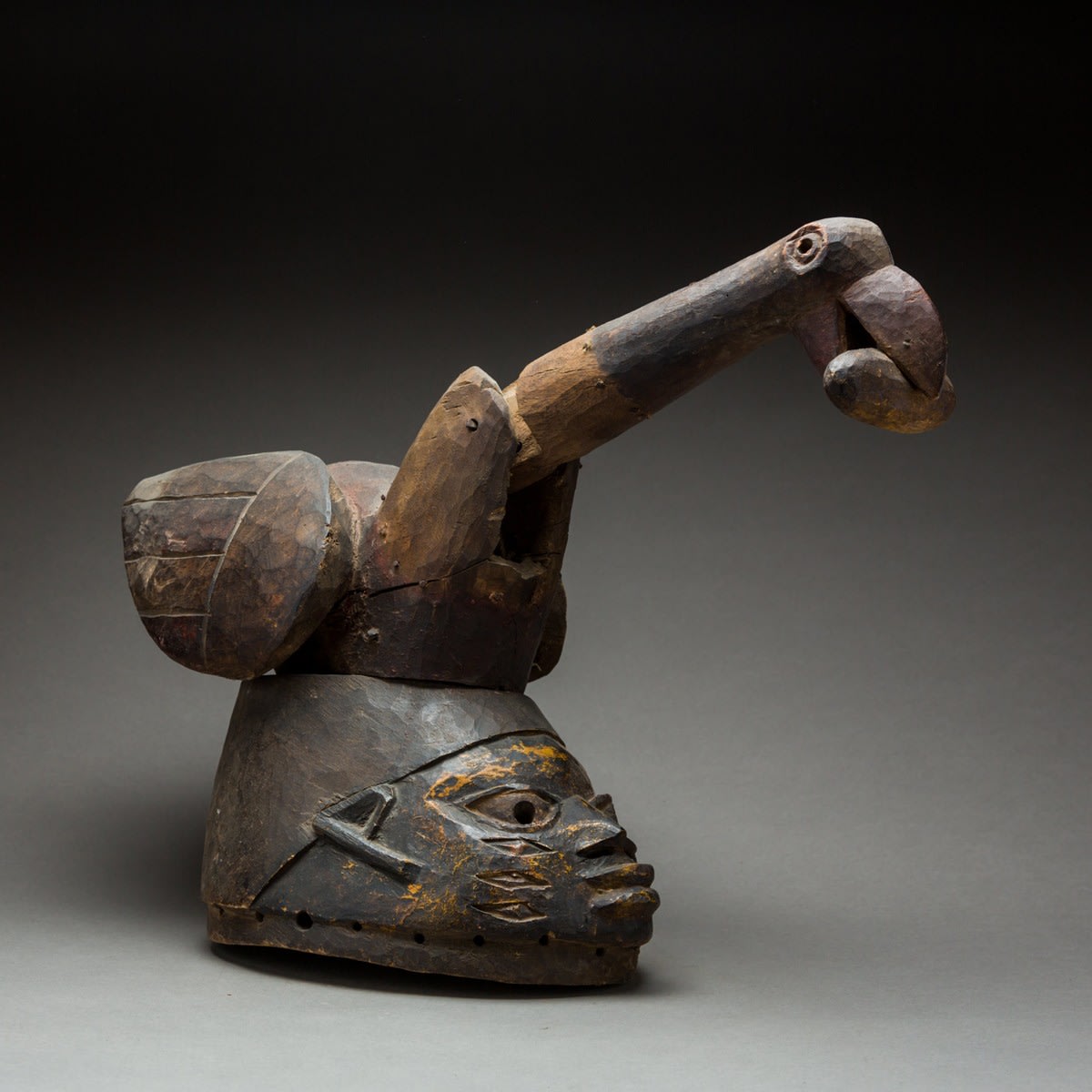Yoruba Egungun Headdress Mask, 20th Century CE
Wood
LO.999 (LSO)
Further images
This unusually ornate mask was made by the Yoruba. It comprises a fairly traditional head cap mask, painted with various layers of yellow and dark pigment around the headily-lidded eyes,...
This unusually ornate mask was made by the Yoruba. It comprises a fairly traditional head cap mask, painted with various layers of yellow and dark pigment around the headily-lidded eyes, flat nose and pursed lips. The head wears a traditional Islamic fez-like hat, reflecting Islam’s powerful influence in Nigeria. Atop this there is a large, seated bird, its wings rendered as large, flaring blocks of wood, with a fan-like tail and a stumpy neck connected to a separate, boom-like slender neck. The head is reminiscent of that of a parrot, with a large, powerful beak wrapped around what appears to be a corn cob, the eyes ringed and pierced. Unusually, the head can be moved by pulling a cord threaded down the aperture in the neck and the bird’s body. The base retains several nails and nail holes which mark out there original position of the cloth costume which was worn with the piece.
Egungun (lit. “power concealed") is the spiritual embodiment of the Yoruba groups’ ancestors, which are honoured in masquerade ceremonies (Odun Egungun) at which masks such as this are worn. The performers enter trances and are possessed by ancestral spirits, which motivates their dancing. The aim of the ceremonies is to maintain the moral standards of previous generations: the dancers spiritually cleanse the community by lampooning morally questionable behaviour known to have been perpetrated by members of the audience. The masks are worn atop the heads of the performers, and with elaborate costumes which conceal the dancers’ identities, ensuring their safety from potential retribution. The tradition has a long history and seems to have grown out of the Oyo Yoruba’s appropriation of a masking tradition originally pertaining to the Nupe, which was then amended somewhat to emphasise its ancestor worship aspects.
The Yoruba are a Central Nigerian tribal group, originally descended from a Hausa migration from the northeast in about 900 AD. A small kingdom – Ile Ife – was founded by Oduduwa, followed by great sociopolitical expansion into Southwest Nigeria, Benin, and Togo. The influence of the city was felt far beyond these boundaries, however, and many smaller political entities were held under its sway. Communities were presided over by the Oba (king) and various senates (Ogboni), and councils made up of guild leaders, merchants and the lesser aristocracy (related to the Oba). The Yoruba have an exceptionally rich and diverse mythology, history and religious context, all of which are directly linked to their artistic output. In Yoruba society, this grouped heritage is known as the Itan, of which this striking mask is a part.
There are numerous variants of Egungun masks, all of which generally refer to the Yoruba people but also to subdivisions of the tribe, as well as village history, family history and even personal history of the carver. This is a striking and powerful piece of Yoruba art.
Egungun (lit. “power concealed") is the spiritual embodiment of the Yoruba groups’ ancestors, which are honoured in masquerade ceremonies (Odun Egungun) at which masks such as this are worn. The performers enter trances and are possessed by ancestral spirits, which motivates their dancing. The aim of the ceremonies is to maintain the moral standards of previous generations: the dancers spiritually cleanse the community by lampooning morally questionable behaviour known to have been perpetrated by members of the audience. The masks are worn atop the heads of the performers, and with elaborate costumes which conceal the dancers’ identities, ensuring their safety from potential retribution. The tradition has a long history and seems to have grown out of the Oyo Yoruba’s appropriation of a masking tradition originally pertaining to the Nupe, which was then amended somewhat to emphasise its ancestor worship aspects.
The Yoruba are a Central Nigerian tribal group, originally descended from a Hausa migration from the northeast in about 900 AD. A small kingdom – Ile Ife – was founded by Oduduwa, followed by great sociopolitical expansion into Southwest Nigeria, Benin, and Togo. The influence of the city was felt far beyond these boundaries, however, and many smaller political entities were held under its sway. Communities were presided over by the Oba (king) and various senates (Ogboni), and councils made up of guild leaders, merchants and the lesser aristocracy (related to the Oba). The Yoruba have an exceptionally rich and diverse mythology, history and religious context, all of which are directly linked to their artistic output. In Yoruba society, this grouped heritage is known as the Itan, of which this striking mask is a part.
There are numerous variants of Egungun masks, all of which generally refer to the Yoruba people but also to subdivisions of the tribe, as well as village history, family history and even personal history of the carver. This is a striking and powerful piece of Yoruba art.





